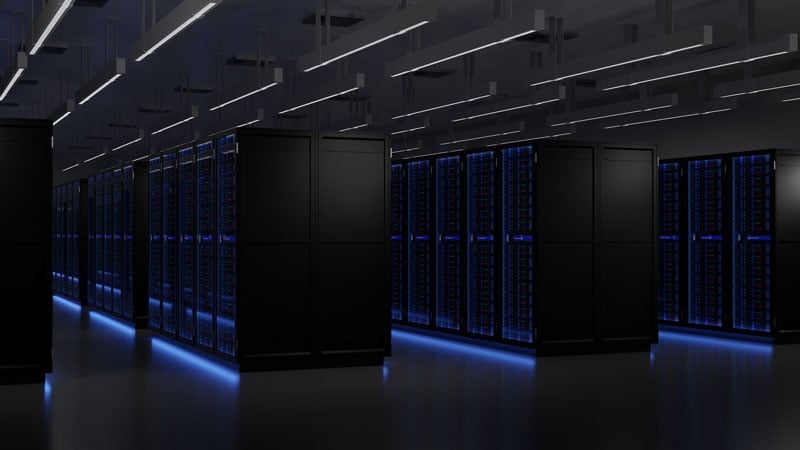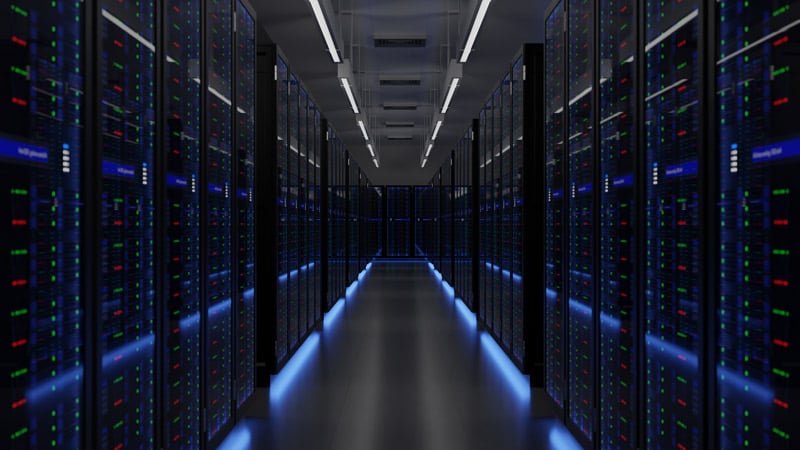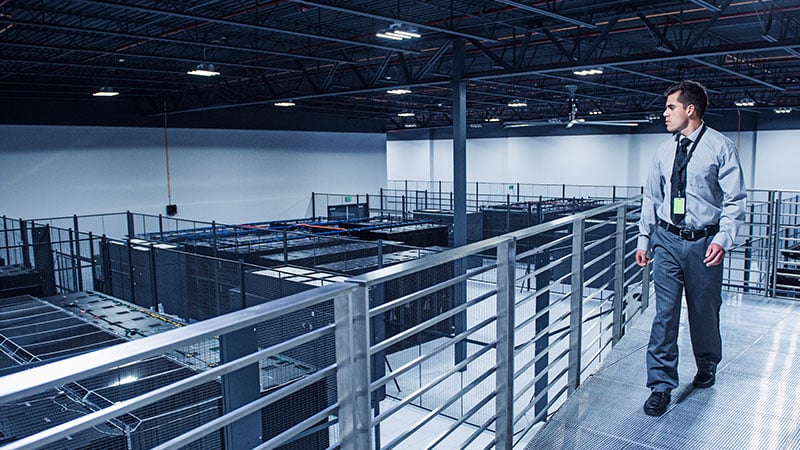Evolving Chilled Water Cooling Methods for Slab Floor Data Centers
Data centers are becoming increasingly complex in terms of size and energy consumption. As a result, efficient data center cooling be implemented to keep up with the demands of these large-scale operations. Chilled water cooling systems have been used for decades as an effective way to control high temperatures in data centers, but they must now evolve to meet the needs of slab floor data center designs.
In this article, we will discuss how chilled water cooling is evolving to meet the requirements of modern data center infrastructure. We will look at current trends and advancements in chilled water cooling technology and assess their effectiveness for keeping data center temperatures stable and consistent while minimizing operating costs.
What is Chilled Water Data Center Cooling?
Chilled water cooling is data center cooling that uses chilled water to transfer heat away from the servers. Chilled water cooling has become an essential part of modern data center infrastructure, as it provides reliable cooling with low energy use and costs. Data centers can improve their thermal management capabilities by combining chilled water and air cooling systems while reducing energy costs.
This is done by using the chilled water to cool down the hottest air in the data center before it reaches the servers. The cooled air is then re-circulated back into the server racks, where it continues to cool down equipment until temperatures are within acceptable limits.
This process ensures that hot spots are avoided, and temperatures remain consistent throughout the data center environment. Organizations can significantly reduce overall operational costs while maintaining optimal performance from their IT infrastructure.
Chilled Water Cooling for Slab Floor Data Centers
This type of cooling system can be used in both raised floor and slab floor data centers, but it is particularly suited for those with a slab floor due to its high-efficiency design. Chilled water cooling provides several advantages over traditional air conditioning systems, including more efficient energy use, lower operating costs, and improved reliability.
However, there are specific considerations when implementing this data center cooling system. These include the need for additional cooling infrastructure, such as pumps and chillers, careful planning around humidity control.
In recent years, the chilled water cooling system for slab floor data centers has seen several significant advancements.
Additionally, advances in automation technology have allowed for greater control over operating temperatures and more efficient management of specific heat loads. This has enabled better, operated data center cooling performance overall and improved system reliability.
Chilled Water and Free Cooling
Chilled water cooling can be augmented with free cooling to increase efficiency. Free cooling uses ambient air temperatures to reduce the need for mechanical chillers. This type of system works best when combined with chilled water to take advantage of both cooling sources.
For example, the chilled water system can be used during peak demand periods, while free cooling takes over during off-peak times. By leveraging both systems, data centers can save money on operating costs while ensuring optimal infrastructure performance.
Chilled Water and Liquid Cooling Technologies
When combined with liquid cooling systems such as immersion or direct-to-chip solutions, chilled water cooling systems can provide even more significant energy savings and improved thermal performance.
Chilled Water Data Center Cooling and Heat Reuse
Heat reuse is an emerging technology that enables data centers to reduce their energy consumption and operational costs by recycling waste heat generated by their servers. Heat reuse systems allow data center operators to capture the otherwise wasted heat from servers and use it for other purposes, such as heating buildings or providing hot water for facilities.
This reduces the energy the data center needs to generate and helps reduce its overall carbon footprint. Heat reuse technology is most effective when integrated with a chilled water system, as the chilled water can be used to cool the servers while the waste heat is recycled for other applications.
Chilled Water and Low GWP Refrigerants
Data centers can further reduce their environmental impact by using low GWP (Global Warming Potential) refrigerants in the cooling system. Chilled water systems utilize earth-friendly refrigerants with low GWP and the chilled water system refrigerant can be outside of the white space.
What Happened to Raised Floor Data Centers?
Slab floor data centers have become increasingly popular with colocation providers due to their many advantages.
First, slab floors allow for more flexibility and scalability than raised floors, enabling colocation providers to expand rapidly by laying down additional equipment without building new structures or installing more complex infrastructure. This also reduces the set-up cost and makes it easier to upgrade facilities as needed. Raised floors require additional infrastructure such as plenums, ducts that can add significant expense and complexity to a project.
Secondly, slab floors are much better suited for high-density deployments than raised floors due to their higher ceilings and improved airflow. This makes them more efficient at cooling IT equipment, making them an attractive solution for data centers with large server workloads or needing to maintain specific temperature requirements.
The continued adoption of slab floor data centers means that chilled water cooling systems will remain an important part of data center operations. With the advances in technology mentioned earlier, it is now possible to efficiently and reliably cool even the densest configurations with minimal energy use. This has enabled organizations to take better control of their thermal management, reduce costs associated with cooling, and ensure optimal performance from their IT infrastructure.
Chilled water cooling systems will continue to be an important part of data center operations as the industry adopts more efficient and sustainable practices to meet the ever-growing demand for IT services.
Considerations for Slab Floor Data Center Cooling
Airflow is an essential factor in keeping a slab floor data center cool. The airflow should be designed to ensure that the hottest air is removed and replaced with cooler air from outside the data center. Hot spots can quickly occur when too much heat is generated, leading to system failures or decreased performance. To avoid this, a well-designed cooling system must be used to ensure that the airflow is optimized for the specific layout of a data center.
Chilled water cooling has become increasingly popular for slab floor data centers because it adapts to different layouts and provides efficient cooling with minimal energy use.
Cooling systems designed for raised floor data centers may improperly impact the thermal management of the data center due to negative pressure at the first row of racks. This can cause air turbulence inside the room and high velocity in front of the server row.
To improve the airflow distribution to the servers and reduce air turbulence, the units designed for chilled water blow air from the coil section exploiting the larger face area. This reduces air speed and creates better airflow distribution. The large face area also allows a positive pressure in front of all the racks, which reduces air turbulence.
There are multiple cooling solutions for a slab floor data center. Vertiv offers the largest selection of CRAH solutions, combined with expert guidance to help you select, implement, and maintain the right technology to ensure delivered performance for the lifetime of your data center.
Vertiv™ Liebert® PCW-PWM
The Liebert® PCW-PWM is an indoor perimeter chilled water unit redesigned for non-raised floor applications. The Liebert PCW-PWM ensures precise and constant airflow, temperature, and humidity control and allows data center operators to deploy an established technology with minimum design modification. The unit has back or front air discharge flexibility to install in the service corridor or data center white space.
Vertiv™ Liebert® CWA Thermal Wall
The Liebert® CWA thermal wall is installed in the service corridor and paired with an air-handling unit (AHU). This cooling unit can achieve a higher cooling density compared to standard chilled water products while maintaining efficiency. As the unit is deeper than most standard units, the Liebert CWA requires that the data center be designed to provide sufficient space in the service corridor.
An air handling unit (AHU) is an integral part of a chilled water cooling system for slab floor data centers.
Vertiv™ Liebert® Custom AHU
The Vertiv™ Liebert® Chilled Water Air Handling Unit is the industry's most advanced chilled water cooling system, providing maximum thermal control. The unit can be customized to customer requirements in wide-ranging configuration options. The Vertiv™ Liebert® AHU can deliver higher-than-average temperatures (22 degrees C) with industry-leading efficiency through the use of water-or-air-side economizations and high-efficiency EC fans.
Establishing Requirements for a Data Center Cooling System
When developing a chilled water design, the data center cooling requirements must begin with the server. First, consider the server quantity, heat density, and airflow. Second, review the server room layout and dimensions, including room height, service corridor space, return air duct, and redundancy. Finally, review the airflow distribution and failure scenario for server rooms, including cooling unit positioning and the first and last row of servers positioning.
Airflow Control in a Slab Floor Data Center
A larger surface area can improve the airflow distribution to the servers, but that is not enough. With a slab floor data center, it is harder to control air distribution when the air is traveling to the racks rather than emerging from the floor. Containment is crucial in improving efficiency and is mandatory for the right amount of airflow from the first to the last server.
Whereas with a raised floor, pressure control is essential, with a slab floor, temperature control becomes more critical. The best way to control air in a slab floor data center is through a temperature sensor that measures the differential temperature between the return and supply air.
A remote sensor can be used to compensate or override fan speed and increase or decrease the supply temperature. Pressure sensors can be used to ensure that minimal airflow is reaching all servers. If there is insufficient containment and air is not getting to the last server, the differential pressure sensor can react and grant a minimum amount of air.
Proper air distribution is mandatory with larger units, and the fan speed offset function can help regulate air flow at the top and bottom of the unit and improve airflow distribution in the room. The offset function can be changed depending on the unit position and room dimensions.
The room should keep the same supply air temperature even when the top and bottom of the unit blow at different air speeds. This capability is only possible due to the specific design of larger units.
The physical separation of the top and bottom units of the Vertiv™ Liebert® PCW-PCM creates cooling redundancy. The controls allow the top and bottom sections to function independently. When the data center heat load is low, running just one-half of the unit is possible, allowing air to flow on the section of the room where you need it.
Ask Vertiv™ About Data Center Cooling Technologies
Chilled water systems are efficient data center cooling systems for slab floor installations. By adopting a chilled water system, data center operators will have the technology ready for future liquid cooling or heat reuse deployments.
Choosing the suitable chilled water units and design allows the data center operator to maximize the cooling density for their specific application. Using the proper control strategy with your chilled water system ensures the right amount of air is delivered to each server, maintaining efficiency and uptime.
Data center cooling is an essential part of any data center, and chilled water systems are becoming increasingly popular for slab floor installations. With the right design and control strategies in place, these systems can provide efficient cooling solutions with maximum density to ensure optimal performance and uptime.
The Vertiv™ Liebert® PCW-PWM, Liebert® CWA thermal wall unit, and custom air handling units all offer unique advantages for different applications that allow operators to get precisely what they need from their cooled water system.
Ultimately, choosing the best chilled water system or data center cooling design will depend on specific requirements. With decades of experience building flexible and customized data center cooling solutions, Vertiv can design a solution tailored to any operator needs.
To learn more about chilled water and other data center cooling technologies, you can read the following white papers:
- How Chilled Water Systems Meet Data Center Availability and Sustainability Goals
- Chilled Water Data Center Cooling for Non-Raised Floor Applications
- Overcoming the Challenges in Cooling Non-Raised Floor Data Centers
Or listen to our latest Engineer's Frontier webinar, How Data Center Chilled Water Cooling is Evolving to Meet the Needs of Slab Floor Data Centers








